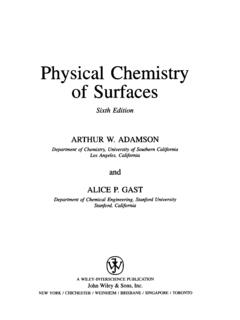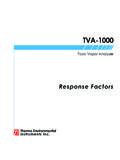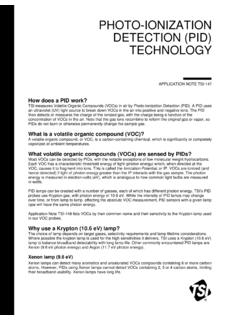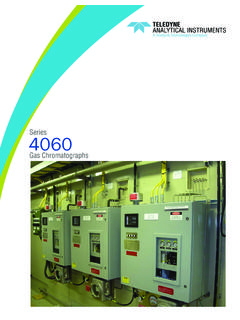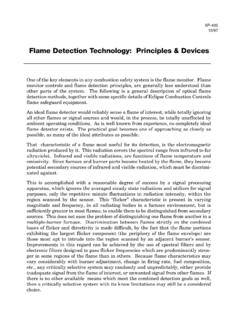Transcription of Introduction Detection limits AAS vs ICP - ScienceNet.cn
1 1 The typical maximum temperature for an air/acetyleneflame is 2 300 C while for nitrous oxide acetylene, it is2 900 C. Temperatures as high as 10 000 K can bereached in an argon limitsThe comparison of Detection limits in table 1 highlightsthe following differences:(i)Furnace AA Detection limits are generally better inall cases where the element can be atomized.(ii) Detection limits for Group I elements ( Na, K)are generally better by flame AAS than by ICP.(iii) Detection limits for refractory elements ( B, Ti,V, Al) are better by ICP than by flame AAS.(iv) Non metals such as sulfur, nitrogen, carbon, andthe halogens ( I, Cl, Br) can only be determinedby it is possible to determine phosphorous by AAS,its Detection limit by ICP is more than three orders ofmagnitude Detection of non metals such as S, N andhalogens by ICP-ES can only be achieved if a vacuummonochromator, with purged transfer optics, is optics must be purged to exclude atmosphericoxygen and eliminating its can be measured at nm by purging themonochromator.
2 To detect the primary aluminiumwavelength at nm, the monochromator mustfirst be evacuated, then purged with the inert that a continuous flow vapor generation accessorycan be used with either ICP-ES or AAS for improveddetection limits for As, Se, Hg, Sb, Bi and - 3 September 1991AA or ICP - Which do you choose?Geoff TylerVarian Australia Pty LtdAustraliaIntroductionFor many analysts Atomic Absorption Spectrometry(AAS) is a well established and understood , even though Inductively Coupled PlasmaEmission Spectrometry (ICP-ES) instrumentation hasbeen commercially available for over a decade, thetechnique has proven to be more complex. This articlediscusses the main differences between the vs ICPThe basic difference between the two techniques is thatone relies upon an atomic absorption process while theother is an atomic/ionic emission spectroscopictechnique.
3 The next essential difference is the meansby which the atomic or ionic species are generated. Acombustion flame or graphite furnace is typically usedfor AA while ICP-ES uses a Height (mm)PlasmaTailNormalAnalyticalZoneInitia lRadiationZonePreheatingZoneInductionZon e Figure 1:A plasma used for emission spectrometry. Theregions refer to those seen when a Yttriumsolution is throughputIn ICP-ES, the rate at which samples may bedetermined depends on the type of instrument: bothsimultaneous and sequential ICP spectrometers areavailable. Most ICP spectrometers purchased are thesequential type, providing maximum flexibility of choiceof element and analytical wavelength.
4 Surveys haveshown that most analysts are interested in 6-15elements per sample and choose to pump the sample(which increases washout times) to improve precisionand accuracy by minimizing viscosity ICP spectrometers demonstrate anadvantage in analytical speed over sequential ICPspectrometers when more than 6 elements/sample a one off sample is presented for a few elements, flame AAS is faster. However, with flame equilibrationtime, program recall and monochromator conditionchanges, the cross over point where sequential ICPbecomes faster than AAS is approximately 6 elements/sample for routine operationFlame AAS cannot be left completely unattended forsafety reasons.
5 An ICP-ES instrument or graphitefurnace AA can be left to run overnight as nocombustible gases are involved, effectively increasingthe working day from 8 hours to 24 dynamic rangeThe inductively coupled plasma is doughnut shaped(with a hollow centre). The sample aerosol enters thebase of the plasma via the injector tube. The opticalthinness of the ICP results in little self absorption and isthe main reason for the large linear dynamic range ofabout 105. For example, copper can be measured at nm wavelength from its Detection limit of ppm to over 200 ppm. In ICP, extrapolation oftwo point calibrations can be accurately used to achieveorders of magnitude above the top standard.
6 Thiscompares to a linear dynamic range of typically 103 interferences are relatively common in AA,especially with graphite furnace AA, but may beminimized with chemical is almost free from chemical interferences. Thechemical bonds that still exist at below 3000 C arecompletely ruptured at above 6000 C. The hightemperatures reached in a plasma eliminate chemicalinterferences, which accounts (for the most part) for thebetter Detection limits achieved for refractory ICP contains a large number of free electrons, soionization interferences for most applications arevirtually nonexistent. Ionization interferences can beencountered when determining elements in matricesthat contain very high concentrations of Group Ielements ( Na & K).
7 However, these effects can beminimized by optimizing the plasma viewing interferences may also be found in AAS, measuring certain Group II elements in a nitrousoxide flame . An ionization buffer such as Cs, Li or Kcan be added to both samples and standards tominimize this optical requirements of AAS are fairly simple. Themonochromator only needs to distinguish a spectral lineemitted from the hollow cathode lamp from othernearby lines. The lamp itself only emits a few spectrallines. Most elements require nm resolution with onlyiron, nickel and cobalt of the common nm or ICP-ES, the rich spectra present in the plasmameans that there is a greater possibility of spectralinterference.
8 Spectral resolutions of nm or betterare required to resolve nearby interfering lines from theatomic and ionic analytical emission signals of interference in sequential ICP spectrometerscan, in most cases, be overcome by selecting adifferent elemental wavelength with similar detectionlimits. With simultaneous ICP spectrometers, theelements and the wavelengths which may bedetermined are fixed at the time of purchase, and analternative line may not be available. In this case, inter-element correction may be used to minimize thespectral interferences relate to the different properties ofvarious samples and can affect sample transport anddroplet formation. ICP tends to be more susceptible tosuch interference because of the smaller droplet sizerequired and lower transport can be termed short term (or within-run) andlong term (over a period of one day).
9 For AAS aprecision of is typical for the short term, butrecalibration is required over a longer period. WithICP-ES the short term precision is typically , butprecisions of 2-5% are not uncommon over an 8 hourperiod without technique used to eliminate backlash in the gratingdrive mechanism of ICP spectrometers is by scanningand measuring at the same time. This method ofmeasurement can be termed as measurement on themove and effectively results in poor short termprecision. A more recent method drives the grating to awavelength near the analytical peak. A refractor scan isthen performed over a smaller wavelength region inorder to identify and locate the peak position.
10 Finally therefractor plate is repositioned at the peak where thereplicate measurements are then performed. Thismethod offers better requirementsBefore deciding which technique is appropriate, thechemist must define both present and future analyticalrequirements. That is:(a) Number of samples/week?(b) What matrices need to be analyzed? steels,bronzes, effluents, soils, etc.(c) How many elements need to be determined foreach sample type?(d) What are the typical sample volumes?(e) What elements need to be determined?(f)What concentration ranges are present in thematrices?(g) Would an Internal Standard be useful? Forexample, where the samples may change inviscosity from sample to sample, battery acidanalysis.

